Leather is a timeless material that can bring a premium look and warm vibe to your home. Just like our skin, each piece of leather is unique, and it changes with age – if you care for it properly, it will maintain its beauty over time. However, when neglected, it can quickly show signs of damage.
To maintain the quality of your leather and help it last for decades, it’s important to clean and condition it regularly. If your leather upholstery is visibly faded, scratched, or stained, it’s past the point of needing to be conditioned, and it’s time to think about leather restoration.
Here, we talk you through how to care for and restore your leather furniture. From regular maintenance to repair and restoration, find out everything you need to know.
Common causes of damage to leather furniture
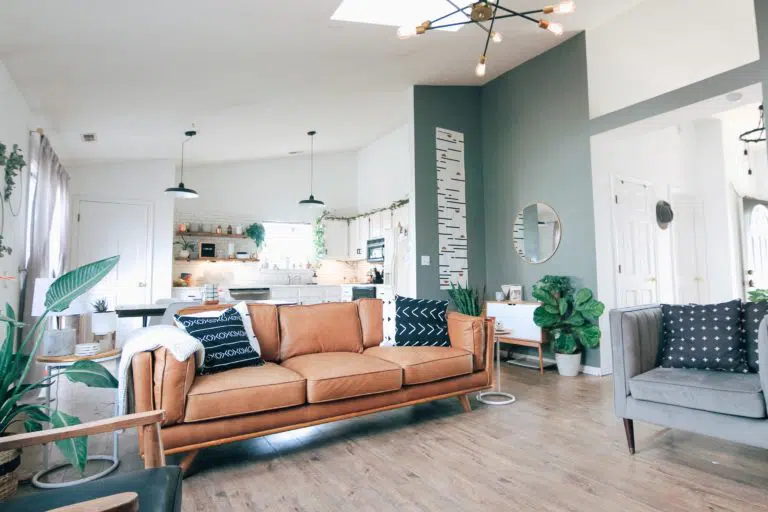
Leather is made from animal skin, and so it is more sensitive to environmental factors than synthetic fabrics (which can easily withstand moisture, high heat and friction). Due to this fact, most leather items are finished with a protective layer on top. When it is not cared for properly, this layer breaks down and the leather is at an increased risk of scratches, tears, stains, and discoloration.
Common things that can damage or dry out leather furniture include:
- Placing it in an area where it’s exposed too much heat or sun
- Keeping it in a room where it’s exposed to too much air conditioning
- Cleaning it with the wrong kind of cleaning products (such as commercial detergents, solvents, all-purpose cleaners, saddle soaps, cooking oils, or silicone)
- When it’s the victim of an unfortunate pet urine accident (and the urine has dried on it)
Proper care and maintenance of leather furniture is key to preventing these issues from occurring, so you can keep your beautiful sofas and chairs in top condition for years to come.
Why does leather need to be regularly cared for?
There are two things that tend to happen when leather furniture is not properly cared for: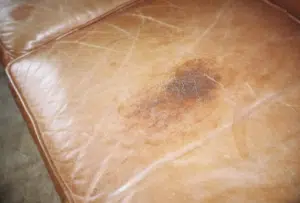
- The topcoat wears off through use and time, which makes the hide vulnerable to marks and stains that leave permanent damage.
- Once the top layer has worn off, the leather is susceptible to the natural oils and body pH of the people and pets using the furniture. The parched hides will start to absorb any moisture they can get- typically body oils from heads, hands, and legs- which results in staining on the leather and accelerates deterioration of the hide. The only way to remove oils that have seeped into the leather is through chemical extraction.
Regular cleaning and routine conditioning is vital in maintaining the top layer and protecting from the piece from external pollutants and hazards.
How to clean a leather couch
Now that you understand the importance of making leather care part of your cleaning routine, learn how to choose the best leather cleaning products that are both safe and effective.
The best leather cleaning products have a balanced pH
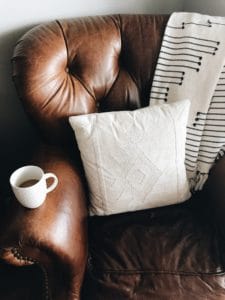
When cleaning any type of upholstery, we have to consider pH – this is the scale of how acidic or alkaline (or basic) a solution is.
Since most soils are
acidic, most cleaning products made to eliminate dirt are more alkaline.
By now we should know: when it comes to cleaning, more is not always more. Detergents with an alkalinity that is too high for the material type can compromise dyes and fiber integrity. This will cause a chemical reaction to break down the delicate leather. Eventually the leather will crack, as the epidermis of the skin loses its integrity and causes irreparable damage.
While a harsh cleaner may promise that “squeaky clean” feeling, it is also speeding up the deterioration of the leather.
It is therefore important that your items are cleaned with a pH-balanced product that has been formulated to use on your type of leather. If you cannot determine the type of finish you have, choose a cleaner than can be used on both finished and unfinished leathers. Be sure to follow the listed instructions with care.
How to clean a leather couch in 3 steps
Pre-test your product under a cushion or in another obscure area and look for color or texture changes that linger after drying. If there are no lasting changes after 2 hours, proceed with the cleaning.
- Remove surface dust regularly, by wiping down finished leather items with a lightly dampened, white cloth.
- Massage a bit of product into a clean, lightly moist white cloth and use a rubbing motion to apply it in sections along the cushions and foundation. Be careful to apply a thin layer, do not oversaturate the furniture. When there are no clean sections left on the cloth, it can be rinsed and wrung out, and used again.
- In our opinion, the best products will air dry in 1-2 hours. Others will specify to dry the leather with a soft, dry cloth.
How to condition a leather couch
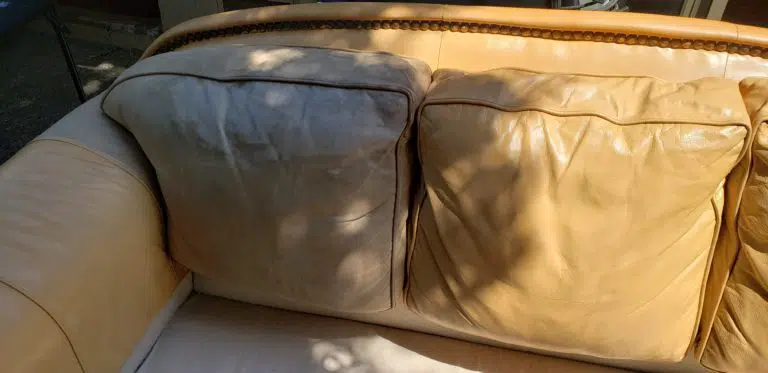
Every 6 months, leather furniture should be conditioned with a specialized leather product. This will restore lost moisture to keep your leather smooth and supple, fortifying it against cracks, scratches, and stains.
When possible, leave conditioning to the pros – they’ll have the knowledge and expertise to ensure the conditioning product and process matches up with the manufacturing style of your leather. If you’re a quick study and have some patience, you should be able to condition your leather using the following guidelines:
1. Identify the type of leather and finish
The best conditioning product for your leather furniture really depends on what type of leather it’s upholstered in. There are many different varieties, which include:
- Unfinished or “Raw” leather: Has no protective coating
- Nubuck: Epidural layer has been sanded and is vulnerable to fading and staining.
- Oil Tanned or “Pull Up”: Dye is not bound to the leather; when you stretch it, you can see the color change, which gives it a distressed appearance.
- Aniline Leather: Not usually pigmented and refers to any leather dyed with aniline dye. Vulnerable to oils.
- Top Grain: The outermost epidermal layer of the hide. Strongest and most finished looking leathers.
- Suede: The bottom of the hide (youngest/immature cells)
- Split Hide: Hide is split along the length, lower quality leather is used on the bottom half of the split or inside of the hide
For more info on different types of leather, explore San Francisco Design’s guide on choosing leather furniture.
2. Find the right conditioning product
The best conditioning product will depend on what type of leather you’re conditioning. It’s important to choose a conditioner that is designed to complement the fibres in your furniture, to ensure you don’t do more harm than good!
3. Apply the conditioner
If you’re certain you have the right conditioning product and you’re attempting DIY leather conditioning, apply it to the clean surface of your furniture in a thin coat.
You’ll need to warm the conditioner – massage and push it through to accelerate the absorption. This can be done using a soft brush, cloth, sponge, or your hands (be sure to wear gloves!)
4. Allow it to absorb
Leave the conditioner for the time specified on the manufacturer’s instructions – usually between 2 and 24 hours. The instructions may state to wipe excess conditioner off with a clean, dry cloth.
How to restore dried out leather
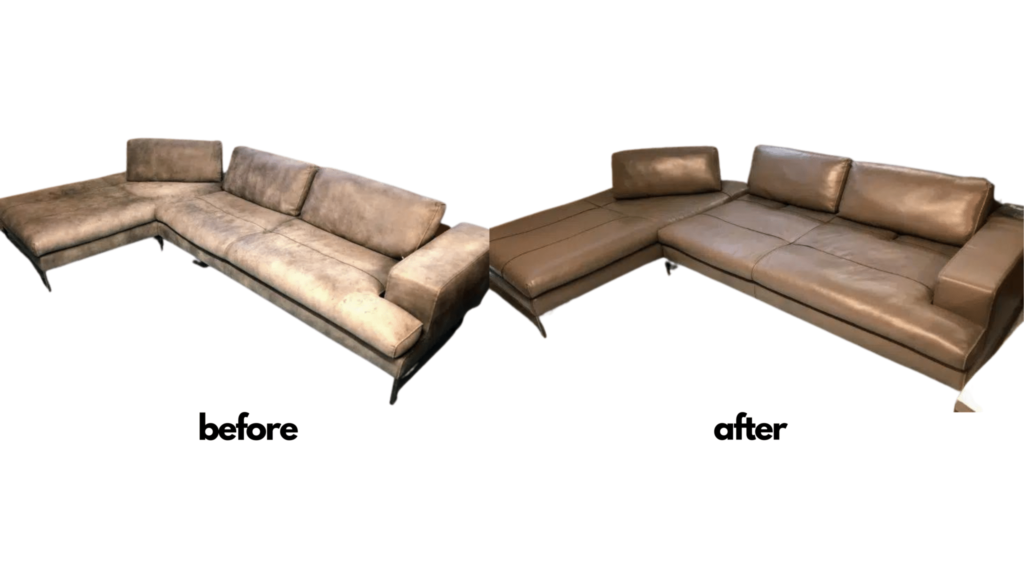
Even caring properly for your leather will not entirely shield it from the hazards of daily life. Whether you have playful pets, curious kids, or simply enjoy a morning coffee on the couch, stains will happen.
If your leather has become scratched, stained, or torn, you may be tempted with some DIY approach you saw posted on social media…but please, resist. Calling in a professional leather restoration service is the best way to ensure that your leather is restored with a uniform look that will last the test of time.
The pros will know how to work with the dyeing, pigmentation and construction techniques to create the appearance and effect that you’re after.
More often than not, proper restoration means that you can’t always get an exact color match for what the piece looked like originally – products or people that advise differently are likely misinformed.
However, a professional restoration job presents a great opportunity to change up the feel of your space and breathe new life into an old piece. You can choose a flat color for a classic finish, or a mottled color, which gives the leather some depth for a unique look.
Our professional cleaners will present you with finish options that are compatible with your furniture, from glossy (patent) to matte, and everything in between.
Leather cleaning and restoration: FAQs
How do you revive old leather?
If your leather furniture hasn’t been regularly maintained, it will require conditioning or restoration, depending on the severity of the dryness and damage.
If you’re attempting a DIY fix at home, find a product that’s compatible with your leather type and follow the manufacturer’s instructions. This usually involves:
- Massaging a thin coat of the product into the surface of your furniture
- Allowing it to soak in for a set period of time
- Removing any residue with a clean cloth
What is the best leather restorer?
The best leather restoration products vary, depending on the type of leather your furniture is upholstered in. Look for a pH-balanced product that is designed for your specific type of finish. When in doubt, choose a cleaner that can be used on finished and unfinished leather and follow the manufacturer’s instructions.
How do you clean pet urine out of leather?
Pet urine (particularly cat urine) can cause odor, staining, and damage due to the acidic content of the urine. Choose an enzyme-based product and apply it generously to the affected area – if the urine soaked through, be sure to apply to the inside of the leather as well.
Just as your leather furniture is as intricate and unique as art, leather conditioning and restoration is a complicated art in its own right that should be carried out by pros who understand the complexities of the materials.
Regular cleaning and maintenance is the best way to ensure your leather sofas and chairs maintain their quality over the long term. Reach out to our team to learn how we can help.
Request a Quote
We’ll be in contact with you shortly to give you an estimate.
